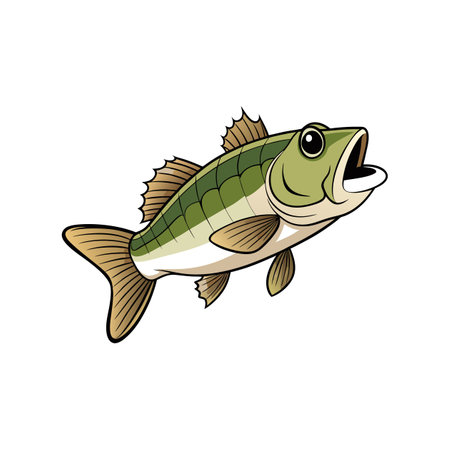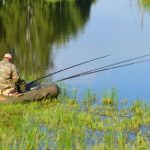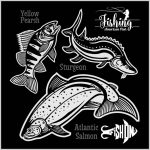1. Understanding Walleye Behavior Through the Seasons
To catch more walleye throughout the year, its important to understand how their behavior shifts with the seasons. These changes are mostly influenced by three key factors: water temperature, daylight hours, and spawning cycles. By adjusting your fishing techniques based on these seasonal patterns, you’ll greatly increase your chances of success.
How Water Temperature Affects Walleye
Walleye are cold-water fish, and their activity levels change depending on the temperature of the water. They tend to be most active in cooler temperatures, especially during spring and fall. Heres a quick guide to their typical behavior at different temperatures:
| Water Temperature (°F) | Walleye Behavior | Best Fishing Tactic |
|---|---|---|
| 32–45°F | Lethargic, slow movement | Jigging near bottom with live bait |
| 46–55°F | Pre-spawn activity increases | Suspend baits near spawning areas |
| 56–68°F | Peak feeding time post-spawn | Casting crankbaits or trolling spinners |
| 69–75°F | Slows down in mid-summer heat | Fish deeper with nightcrawler rigs |
| 76°F+ | Seek cooler, deeper waters | Bounce jigs off deep structure early or late in day |
The Role of Daylight Hours
Daylight also plays a big role in walleye behavior. These fish are known for being low-light feeders, which means early mornings, evenings, and overcast days are prime times to catch them. In summer when daylight lasts longer, they often feed at night or during twilight hours. In winter, shorter days make midday bites more common.
Spawning Cycles and Seasonal Movement
The spawn is one of the biggest factors influencing where walleye go and how they act. In early spring, as water temps rise above 40°F, walleye move into shallower rivers or rocky shorelines to spawn. Post-spawn, they disperse into nearby drop-offs and feeding flats. During summer, they head to deeper waters to stay cool. In fall, they return to shallower areas to bulk up for winter. In winter months under ice, they slow down again but can still be caught by targeting deeper basins and using finesse techniques.
Seasonal Walleye Movement Overview:
| Season | Main Location | Main Behavior |
|---|---|---|
| Spring | Shallow rivers and rocky shores | Spawning and aggressive feeding after spawn |
| Summer | Deeper lakes and structure zones | Avoiding heat, feeding early/late or at night |
| Fall | Mid-depth flats and weed edges | Binge feeding before winter sets in |
| Winter | Deep basins beneath ice cover | Lethargic but still feeding on easy targets |
The better you understand how walleye respond to seasonal changes in temperature, light, and biology, the better you’ll be at finding them—and catching them—year-round.
2. Spring Strategies: Targeting Post-Spawn Walleye
Spring is a prime time for walleye fishing, especially right after the spawn. As water temperatures begin to rise and days get longer, walleye move from their spawning areas back into feeding zones. This makes them more predictable—and hungry.
Understanding Post-Spawn Behavior
After spawning, which usually occurs in water temperatures between 42°F and 50°F, walleye are tired and need to feed to regain energy. They often stay close to their spawning grounds before gradually moving to deeper or transitional areas.
Key Locations for Spring Walleye
Look for these high-percentage spots:
| Location | Description |
|---|---|
| Shallow Flats | Warming waters attract baitfish, drawing in hungry walleye. |
| Current Breaks in Rivers | Walleye rest behind structure like rocks or bridge pilings where they can ambush prey. |
| Mouths of Tributaries | Where rivers flow into lakes—great ambush points with warmer inflow. |
| Drop-offs Near Spawning Grounds | As they transition from spawning areas, walleyes often hold here. |
Best Tactics and Presentations
In spring, finesse is key. The water is still cool, so slower presentations tend to work better. Here are three proven techniques:
1. Jigs with Soft Plastics or Live Bait
A 1/8 oz to 1/4 oz jig tipped with a minnow or soft plastic tail works well in rivers and along shallow flats. Bounce it slowly along the bottom to mimic a wounded baitfish.
2. Live Bait Rigs
Use a slip sinker rig with a leech or nightcrawler on a #4 or #6 hook. Slowly drag the rig along drop-offs or near current seams where post-spawn fish are holding.
3. Casting Crankbaits in Shallow Water
If water temps climb quickly, some walleyes may chase down faster-moving baits. Try casting shallow-running crankbaits early morning or late afternoon when light levels are low.
Tackle Tips for Spring Success
| Gear Type | Recommendation |
|---|---|
| Rod & Reel | Medium-light spinning combo with good sensitivity for feeling light bites. |
| Main Line | 6-10 lb fluorocarbon for clear water, or braid with a fluorocarbon leader for better feel. |
| Bait Choices | Minnows, leeches, nightcrawlers, and small paddle-tail plastics work best in spring. |
Bonus Tip:
If you’re fishing rivers after heavy spring rains, focus on slack water just outside the main current. Walleyes will stack up there waiting for food to drift by without using too much energy.

3. Summer Tactics: Finding Deep-Water Walleye
As summer heats up, walleye move to deeper, cooler waters in search of comfort and food. This shift means anglers need to change their approach. Shallow water techniques from spring won’t cut it anymore. Instead, successful summer fishing is all about locating the fish using electronics and presenting your bait at the right depth and speed.
Use Electronics to Find Structure and Fish
One of the most important tools for summer walleye fishing is a reliable fish finder or sonar unit. During the warmer months, walleye tend to hang out near underwater structures like drop-offs, humps, rock piles, and submerged points. These areas provide shade, cooler water temperatures, and plenty of baitfish.
Key Structures to Target in Summer
| Structure Type | Why Walleye Like It |
|---|---|
| Drop-offs | Offer quick access to deep water and feeding opportunities |
| Rock Piles | Hold heat and attract baitfish |
| Humps & Reefs | Create vertical structure that draws in predators and prey |
| Main Lake Points | Provide current breaks and ambush zones for feeding walleye |
Trolling Crankbaits for Suspended Fish
Trolling is one of the most effective ways to cover water and find active summer walleye. Crankbaits are especially useful because they can dive to precise depths where fish are holding. Use longer line lengths or lead core line to reach deeper zones, and vary your trolling speed between 1.5 to 2.5 mph depending on the crankbait type.
Trolling Tips:
- Use planer boards to spread lines and avoid spooking fish.
- Match lure colors to the water clarity—bright colors for stained water, natural patterns for clear lakes.
- Watch your electronics for bait clouds and target nearby depths.
Bottom Bouncing with Live Bait Rigs
If trolling isn’t producing, switch gears to bottom bouncing with a live bait rig. This method allows you to present nightcrawlers or leeches right along the lakebed where many walleyes lurk during mid-day hours. A bottom bouncer weight keeps your rig in place while allowing your bait to float just above the bottom.
Best Conditions for Bottom Bouncing:
- When walleye are hugging structure like rock edges or weed lines.
- During midday when fish are less aggressive but still feeding.
- On windy days when boat control is more challenging—bottom bouncers stay in the strike zone longer.
Mix It Up for More Success
No single method works every day. Some days trolling will be hot; others will call for slow presentations near bottom. The key is to stay flexible, trust your electronics, and experiment with different tactics until you find what works best on that particular day and lake.
4. Fall Approaches: Capitalizing on the Feeding Frenzy
As the water cools down and daylight hours shrink, walleye enter one of their most aggressive feeding periods of the year. Fall is prime time to catch big, trophy-sized walleye as they bulk up for winter. This season is all about finding structure-rich areas and using techniques that match their heightened feeding instincts.
Why Fall Is a Game-Changer for Walleye Anglers
During fall, water temperatures drop into the 50s and 60s (°F), triggering a biological response in walleye to feed heavily before winter sets in. They become more predictable and tend to school up around key structures, making them easier to target if you know where to look.
Top Fall Locations for Walleye
Look for these types of structure-rich spots where baitfish gather and walleye are likely to follow:
| Structure Type | Description | Why It Works |
|---|---|---|
| Rocky Points & Drop-offs | Edges where shallow flats meet deeper water | Walleye use these as ambush zones during feeding times |
| Submerged Timber | Old sunken trees or logs in lakes or reservoirs | Provides cover for both baitfish and walleye |
| Main Lake Humps | Underwater high spots surrounded by deep water | Bait congregates here, drawing in predator fish like walleye |
| Mouths of Creeks & Rivers | Where flowing water enters a lake or reservoir | Nutrient-rich areas that attract schools of baitfish |
Effective Fall Techniques
This season is all about matching your tactics with the aggressive behavior of fall walleye. Here are two proven methods:
Vertical Jigging Over Structure
Using heavy jigs tipped with minnows or soft plastics, drop directly over humps, points, or drop-offs. Slowly lift and lower your jig to entice strikes from suspended or bottom-hugging fish.
Pro Tip:
A sonar unit helps you locate schools of baitfish and pinpoint exactly where walleye are holding in the water column.
Casting Swimbaits Along Edges
Cast paddle-tail swimbaits near rocky shorelines, weed edges, or timber. Use a steady retrieve with occasional pauses to mimic an injured baitfish—this often triggers aggressive strikes.
Bait Suggestions:
- 3″–5″ paddle-tail swimbaits in natural colors like perch or shiner patterns
- Jig heads between 1/4 oz to 3/8 oz depending on depth and current
- Add scent attractants for extra appeal during tough bites
Best Times to Fish in Fall
The bite can be strong throughout the day in fall, but here’s when you’ll likely see the most action:
| Time of Day | Bite Activity Level |
|---|---|
| Dawn (6 AM – 8 AM) | High – active feeding starts early as light breaks through |
| Midday (11 AM – 2 PM) | Moderate – fish may move slightly deeper but still feed actively |
| Dusk (5 PM – 7 PM) | Very High – one of the best windows as light fades and temps cool further |
This is your chance to hook into some of the biggest walleye youll see all year. With the right location and technique, fall fishing can be both exciting and rewarding.
5. Winter Ice Fishing Tips: Catching Walleye Beneath the Ice
When winter rolls in and lakes freeze over, walleye fishing doesn’t stop—it just changes. Ice fishing for walleye can be incredibly rewarding if you understand how to adapt your strategy to the cold conditions. Mastering the essentials like sonar use, proper jigging technique, and choosing the right location and time of day can make all the difference.
Use Sonar to Find Active Fish
In winter, walleye tend to move less and school up near structure like drop-offs, humps, or submerged points. A reliable ice fishing sonar (flasher or LCD unit) helps you pinpoint their exact depth and see how they respond to your lure in real time. Look for baitfish clouds and suspended marks—these are often signs that walleye are nearby.
Jigging Spoons and Lure Selection
Jigging spoons are a go-to bait for winter walleye because they mimic struggling baitfish and trigger reaction strikes. Choose spoons with flash and vibration to attract fish from a distance. Tip them with a minnow head or soft plastic for added scent and action. Other effective lures include:
| Lure Type | Best Use |
|---|---|
| Jigging Spoon | Active jigging near structure |
| Rattle Bait | Calling in fish from a distance |
| Deadstick Jig with Minnow | Passive presentation when bites are light |
Selecting the Right Location
Walleye often hold near mid-depth structures during early ice (first few weeks), then move deeper as winter progresses. Focus on these key areas:
- Early Ice: Shoreline breaks, weed edges, shallow flats near drop-offs
- Mid-Winter: Deep humps, main lake basins, channel edges
- Late Ice: Move back toward shallower spawning areas
The Best Time of Day for Winter Walleye
Just like other seasons, timing is critical in winter. Walleye are most active during low-light periods—early morning and late afternoon into dusk. Set up before sunrise or stay until after sunset for your best shot at a limit.
Winter Bite Time Table
| Time of Day | Bite Activity Level |
|---|---|
| Pre-Dawn (5AM – 7AM) | High |
| Midday (10AM – 3PM) | Low to Moderate |
| Dusk (4PM – 6PM) | High |
Staying mobile is key—if youre not marking fish within 15–20 minutes, drill new holes and keep moving until you find active schools. Bundle up, stay safe on the ice, and enjoy some of the season’s most exciting walleye action.


